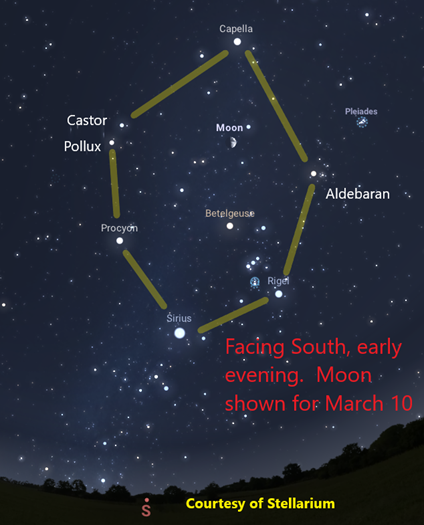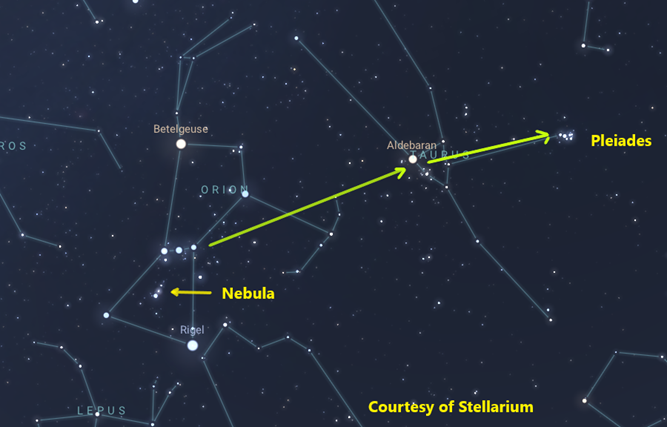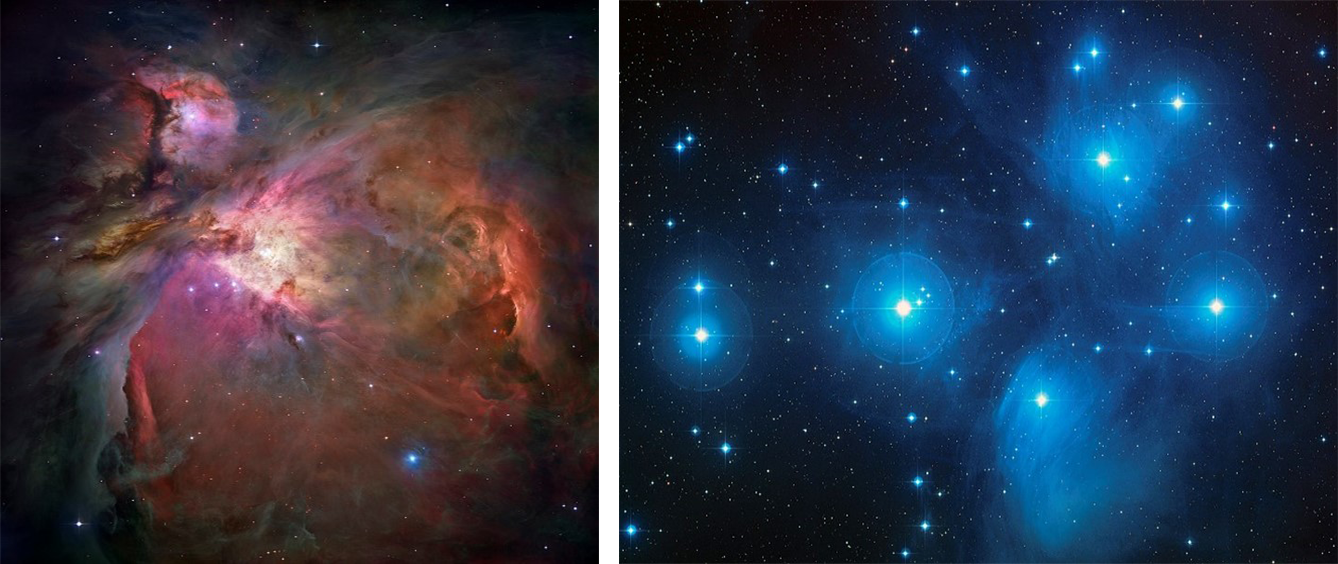A Deeper Look
In many ways, the winter is the best time to go stargazing. The haze that blankets the sky during the summer is usually absent, and the cold nights feature far more bright stars than at any other time of year. The only bad part is the cold, but it usually isn’t that bad in St. Louis, and of course you can always bundle up. March offers the best of both worlds, with the bright stars of winter still lingering, and the temperatures warming as the days lengthen.

Seven bright stars help form the Great Hexagon (also called the Winter Hexagon) a huge landmark of the skies, with an eighth, Betelgeuse, roughly marking its center. The Hexagon was covered in great detail in the March 2020 and March 2021 editions of this blog- feel free to review these issues as they focus on these stars and their accompanying constellations and mythology. The moon will pass through the Great Hexagon March 9-12 this year, centered best on the night of the 10th, as shown above. It is quite easy to start with Sirius, the lowest and brightest star, and follow your way through the whole pattern. All of these stars are easily visible to the unaided eye, even if you are located in the city.
The stars of the Hexagon also point the way to two of the most spectacular deep-sky objects in our night skies- the Orion Nebula and the Pleiades (Seven Sisters) cluster.

The constellation Orion, the Hunter has more bright stars than any other, with the famous stars of the belt surrounded by a rectangle of even brighter stars. Look very closely below Orion’s belt for a small line of three much fainter stars, known as the hunter’s sword. The middle star in the sword may look just a little fuzzy to the unaided eye, and this stands out much better in binoculars or a small telescope. This is none other than the Orion Nebula, a cloud of gas that is illuminated by a tiny group of stars inside. These stars condensed out of this gas cloud in the recent past, celestially speaking. The Orion Nebula is so far away that its light takes about 1,300 years to get to your eyes, traveling at a speed of 186,000 miles a second or 6 trillion miles a year.
If you draw a line through Orion’s belt stars to the upper right, you first come to the bright orange star Aldebaran, and then you can continue to the Pleiades, or Seven Sisters star cluster. Easily visible as a fuzzy patch to the unaided eye, a close look shows about six individual stars within the cloud, in the shape of what some people regard as a tiny dipper- but the real Little Dipper is in the northern sky, with the North Star (Polaris) at the end of the handle. Sharp-eyed people can sometimes glimpse more than six stars with their unaided eyes, with binoculars bringing out still more. The April 2020 issue of this blog has more about the Pleiades, which are one of my favorite objects in the sky. In fact, my wife and I named our daughter after one of the stars!
The Pleiades might be regarded as a glimpse of the future of the Orion Nebula. The gas which forms the nebula has already condensed into about 500 stars, as can be seen in the picture below. The stars shine so brightly because the Pleiades are much closer to us than the Orion Nebula, about 440 light years away. Light from the Orion Nebula left at the time of the Early Middle Ages, while that from the Pleiades departed just before telescopes were invented. One of the most fun parts about stargazing is this sense of timelessness. In the time frame of the universe, both of these objects are quite new and will not last long. Within a few hundred million years, not even one twentieth of the age of the universe, the clouds and gas that we see today will all be dispersed.

Orion Nebula (left) and the Pleiades Cluster (right.) Both images courtesy NASA
Join us for our first Gateway to the Stars program of 2022. On Saturday evening, May 28, St. Louis Astronomical Society President Jim Small will discuss “The Globe at Night,” a campaign in which YOU can aid science by helping to measure the degree of light pollution in your area, using nothing more than a smartphone or tablet. This program is scheduled to take place at 6:45pm in the Education Classroom in the Gateway Arch Visitor Center. Weather permitting, free telescope viewing will be available on the plaza outside the Visitor Center west entrance after this educational program. All Gateway to the Stars activities are free, as is admission to the Museum at the Gateway Arch. Fees apply for the tram ride to the Top of the Arch, Monument to the Dream video, and Gateway Arch Riverboat rides.
